This autumn, The COMP Magazine visited Assaf Evron’s Mana studio. During the session, a range of topics was discussed, including: the process of photographic portraiture, revisiting the work of early 20th century artists and the significance of philosophy in the art-making process. In this Q&A interview, Assaf Evron, a thoughtful educator and practicing artist, offers an introduction into his current investigations and the subtle differences between the Midwest and Middle East.
Can we start with a compare and contrast on how place has influenced your practice? You have worked in Israel and Chicago, studied at Tel Aviv University and the School of the Art Institute. Do you see any differences in how you look at or approach your artistic practice due to place?
When I arrived in Chicago I gave up very fast on translating Fahrenheit to Celsius. 40F in Chicago feels nothing like 5C in Tel Aviv and vice versa. It is almost an impossible task to compare and contrast; those are two different worlds and two different modes of existence. I can say that Chicago has an enormous mental and physical space and processes are slower there is access to materials and fabrication facilities. I have an incredible studio at the Mana Residency Program and I can be there for days without interference. Those marked a shift of wait in my work to studio practice rather them photographing on site. This is a solitary existence that can be very productive. Though I miss the intensity and centrality of Tel Aviv.
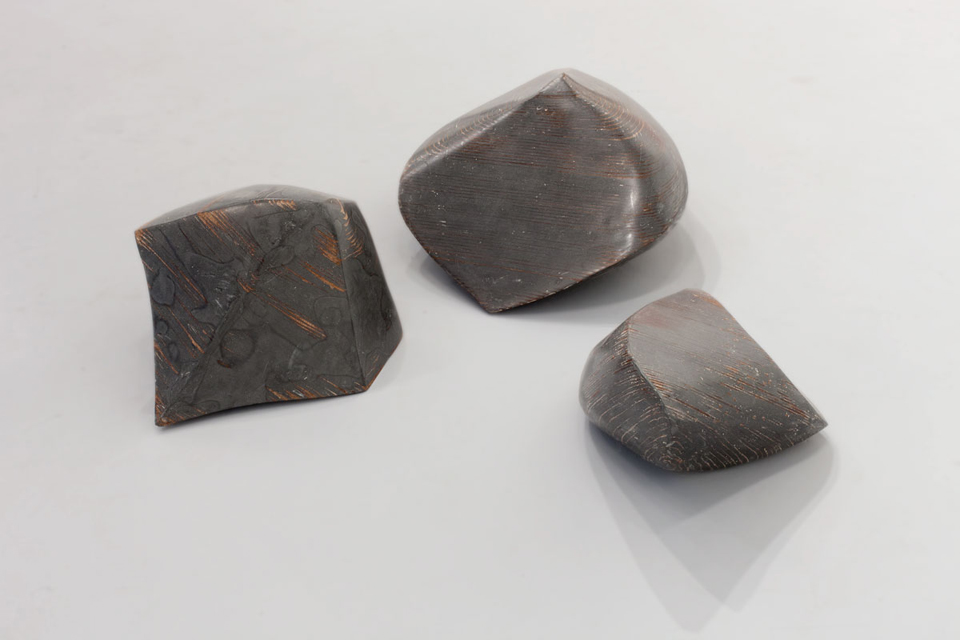
Assaf Evron, Floor sculptures, Untitled (SWOP tr0001.icc), 2013, Epoxy/MDF, 20”/25”/22”
Untitled (E-R-XY.icc), 2014, Epoxy/MDF, 20”/25”/22”
Untitled (E-R-LAB.icc), 2014, Epoxy/MDF, 20”/30”/25”
In a conversation with Galia Bar Or, you stated, “I do not photograph the obstructed gaze, but rather the surface of the obstructing wall, the improvised barrel wall, rather than the gaze onto the outside, onto the water reservoir in the horizon. I shoot the netting itself, not through it. I always associate the surface with the present. Perhaps this is my way to try to capture the visible.” This is from a rather interesting and thoughtful conversation. Often, in photography dialogues critics and artist identify the medium as being deceptive. There are a number of arguments that have supported this stance linking it to a surface reading. In your conversation you link a number of factors to this idea, for instance “time” appeared to be of importance. And, I also believe “time” to be one of the defining factors for the medium. Can you offer some expansion on this statement?
Deception is an inherent character of vision even before thinking about photography this is a given and the question is how do you operate within he visual field. My photographs in general are simple and direct though aspire to challenge our expectations from the visual image.
In that body of work I was looking for an alternative to the perspectival gaze. Although the optics of the camera constructs perspectival space, I looked at the surface as a carrier of its own history that accumulates on it. The photograph registers this as present tense.
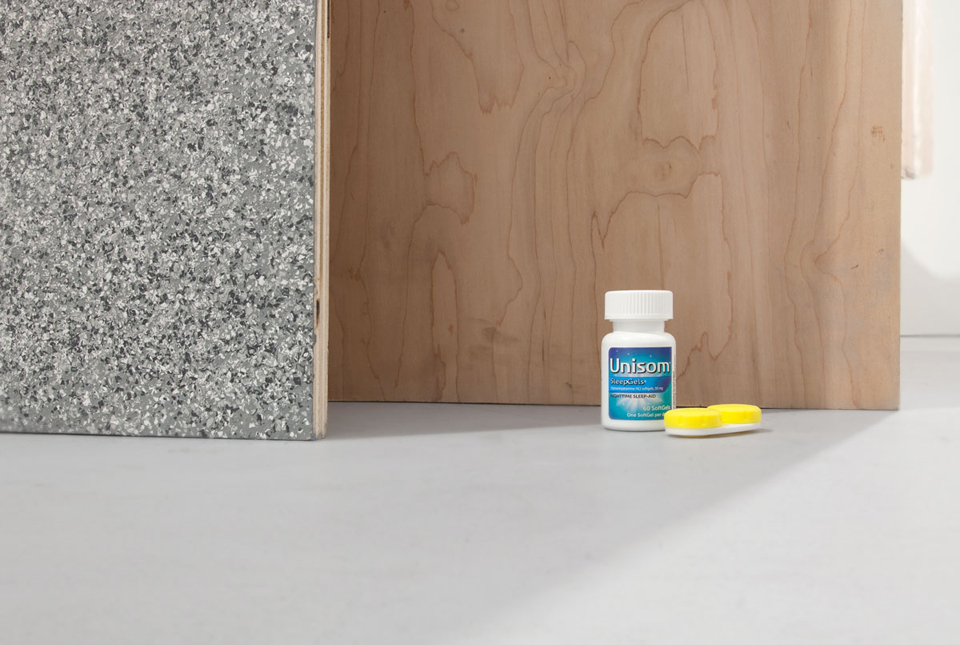
Assaf Evron, Puppies Puppies, Untitled, (Contact lens case)(Yellow)(green™), 2014, Readymade, 5/2.5/1.25 inch
Untitled, (Unisom)(Sleeping pills)(Blue)(green™), 2014, Readymade, 2.5/1.5 d. inch
at Hyde Park Art Center, Chicago
There appears to be strong ties to philosophy in your work. Can you discuss this fascination?
Philosophy asks basic question about the world. As art practice does that just in a different register. Philosophy is another mode of asking question or addressing similar issues with different tools. As artist we operate within culture and though theory is not inspiration is context in a very abstracted way like music that is played somewhere in the back of my head.
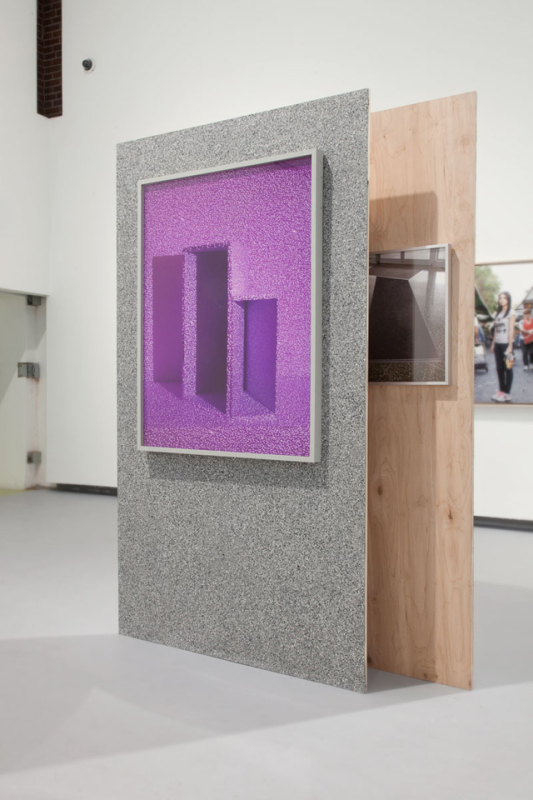
Assaf Evron, Untitled (visual pyramid after Alberti), 2013, Infra red photograph/ XBOX kinect, 33”/44” each
Architectural support – ply wood/epoxy paint/decorative flaks, 4’/7’2” each
at Hyde Park Art Center, Chicago
You have been working on a Chicago series since 2011. Can you discuss the approach and intent of this work?
Well the Chicago series is just a way to address the work I have been doing in the last 3 years by tying it to a geography was a way to unify a heterogeneous body of work under the arbitrariness of place and time. Having said that my interests in the past years are questions of representation and the construction on the image and space.
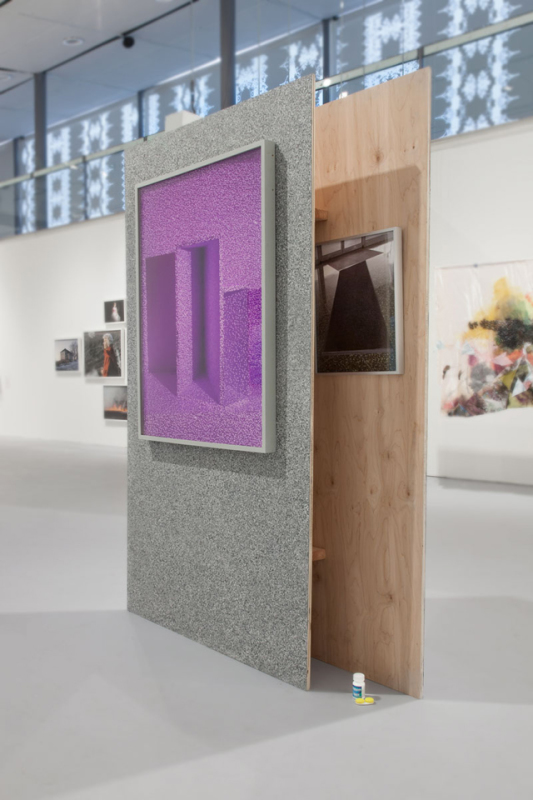
Assaf Evron, Untitled (visual pyramid after Alberti), 2013, Infra red photograph/ XBOX kinect, 33”/44” each
Architectural support – ply wood/epoxy paint/decorative flaks, 4’/7’2” each
at Hyde Park Art Center, Chicago
What is your future plans? Are you preparing for any exhibitions or new projects?
Right now I am showing at ground floor at Hyde Park Art Center. In addition, the work, Spolia, is at Haifa Museum of Art in Israel and Numima is being presented at Vox Populi in Philadelphia.
In March I am going to have a solo show with Andrea Mieslin Gallery in New York.
Assaf Evron was born in Tel Aviv, Israel and now lives and works in Chicago. He has held solo exhibitions at Inga Gallery, Tel Aviv; Habres + Partner Galerie, Vienna; University of Richmond; and the Haifa Museum of Art. At this very moment, Assaf is most likely reading comparative philosophy or building a light-based sculptural experiment to be photographed.
To view additional artwork and writings on Assaf Evron, please visit:
Assaf Evron – http://assafevron.com/
Inside the Artist’s Studio – https://www.youtube.com/watch?v=EK8t4K1ET44
WBEZ Interview – http://www.wbez.org/blogs/alison-cuddy/2013-10/chicago-global-artist-tel-aviv-photographer-and-sculptor-assaf-evron
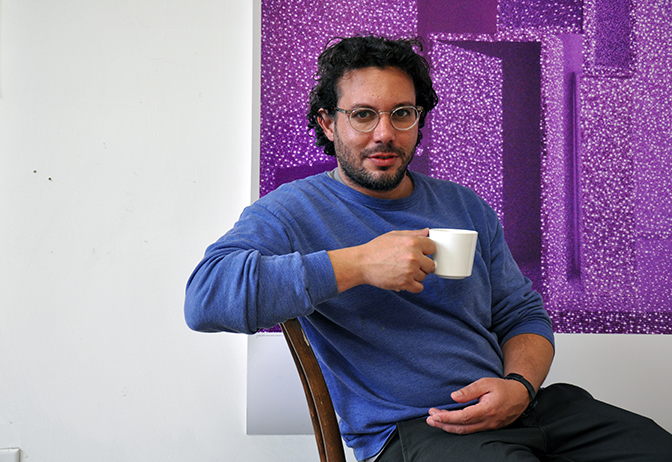
Assaf Evron, artist, Chicago, IL, 2014
Interview and portrait by Chester Alamo-Costello


